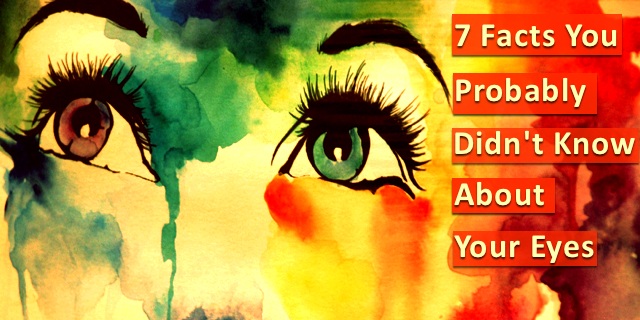“Love looks not with the eyes but with the mind.” ~ Shakespeare
“Eyes that do not cry, do not see.” ~Proverb
Great poetry has been written about the eyes. Yet do you know much about them? Let’s follow light as it goes into your eye, take a look at the inside of your eyes and learn some facts you probably didn’t know.
![]() What we see of our eyes is only a small portion of the whole structure. Our eyes are about the size of a ping pong ball. Tears are made up of water, mucous, oil and antibodies. Tears provide moisture to keep the cornea from being infected.
What we see of our eyes is only a small portion of the whole structure. Our eyes are about the size of a ping pong ball. Tears are made up of water, mucous, oil and antibodies. Tears provide moisture to keep the cornea from being infected.
![]() The cornea is the transparent, clear tissue in the front of the eye. Around it the white part covering your eye is called the sclera. Right behind the cornea is a space filled with liquid called aqueous humor. This fluid is transparent and nourishes the structures in front of the iris.
The cornea is the transparent, clear tissue in the front of the eye. Around it the white part covering your eye is called the sclera. Right behind the cornea is a space filled with liquid called aqueous humor. This fluid is transparent and nourishes the structures in front of the iris.
“The eyes are the windows to the soul.” ~Proverb
![]() The colored part of your eye is called the iris. Muscles attached to the iris change its shape and control the amount of light that enters the eye through an opening called the pupil.
The colored part of your eye is called the iris. Muscles attached to the iris change its shape and control the amount of light that enters the eye through an opening called the pupil.
Human eye color is caused by melanin in the iris. The iris colors are classified as amber, blue, brown, gray, green, hazel, or red. Brown is the most common color while green is the least common. Red or pink eyes are caused by albinism, which means no melanin. The red or pink that is seen is the red of the retina.
 Green eyes are the most rare; only 2% of the population has green eyes.
Green eyes are the most rare; only 2% of the population has green eyes.
Blue eyes are recessive: about 8% of the world population has blue eyes. Since as many as 16 genes affect eye color, parents with brown eyes can produce children with blue or green eyes.
![]() Muscles attached to the iris control the size of the pupil. These muscles weaken as we age which is why people over 60 may have difficulty seeing when moving from dark to bright areas or have difficulty driving in the dark.
Muscles attached to the iris control the size of the pupil. These muscles weaken as we age which is why people over 60 may have difficulty seeing when moving from dark to bright areas or have difficulty driving in the dark.
![]() The light passing through the pupil and hits the lens. The lens is clear and focuses light on to the retina. Fibers suspend the lens in the eye and are attached to a muscle called the ciliary muscle. The ciliary muscle changes the lens shape depending on the distance from the object you are focused on. To see close to you, the ciliary muscle makes the lens thicker and to look at objects farther away, the lens is made thinner.
The light passing through the pupil and hits the lens. The lens is clear and focuses light on to the retina. Fibers suspend the lens in the eye and are attached to a muscle called the ciliary muscle. The ciliary muscle changes the lens shape depending on the distance from the object you are focused on. To see close to you, the ciliary muscle makes the lens thicker and to look at objects farther away, the lens is made thinner.
Light passes through the vitreous humor which is the fluid that fills the chamber between the lens and retina, continuously bathing these structures in nutrients and maintaining the shape of the eye.
“Behind the most beautiful eyes lay secrets deeper and darker than the mysterious sea.” ~Anonymous
![]() The image that reaches the retina is upside down.
The image that reaches the retina is upside down.  The retina is made up of photoreceptor cells called rods and cones and the blood vessels that nourish them. There are 7 million cones and 120 million rods in each eye. The macula is an area of the retina with a high concentration of cones, the photoreceptors responsible for detailed vision and the ability to see color. There are three types of cones each receptive to a different color-red, blue and green. Rods are primarily for black, white and gray vision, they are more sensitive to light and are important in night vision and peripheral vision. The rods and cones transform the shapes and colors you see into messages that are carried on nerves.
The retina is made up of photoreceptor cells called rods and cones and the blood vessels that nourish them. There are 7 million cones and 120 million rods in each eye. The macula is an area of the retina with a high concentration of cones, the photoreceptors responsible for detailed vision and the ability to see color. There are three types of cones each receptive to a different color-red, blue and green. Rods are primarily for black, white and gray vision, they are more sensitive to light and are important in night vision and peripheral vision. The rods and cones transform the shapes and colors you see into messages that are carried on nerves.
![]() Each photoreceptor cell is linked to a nerve fiber that combined together to form the optic nerve. Each eye has an optic nerve that carries information to the back of the brain to be interpreted.
Each photoreceptor cell is linked to a nerve fiber that combined together to form the optic nerve. Each eye has an optic nerve that carries information to the back of the brain to be interpreted.
 There is a place where the two optic nerves meet called the optic chiasm that is right behind the eyes. There half of the nerve fibers from each eye cross over to the other side. So half of the nerve fibers from your right eye actually go to the left side of your brain and half of the nerve fibers from your left eye travel to the right side of your brain. Because each eye sees different angles of an object, this allows the brain to integrate the information and helps us to see depth.
There is a place where the two optic nerves meet called the optic chiasm that is right behind the eyes. There half of the nerve fibers from each eye cross over to the other side. So half of the nerve fibers from your right eye actually go to the left side of your brain and half of the nerve fibers from your left eye travel to the right side of your brain. Because each eye sees different angles of an object, this allows the brain to integrate the information and helps us to see depth.
Each eye is moved by cranial nerves. The information received by those nerves are also integrated by the brain to provide the picture of the world that we see.
As you can see, the eyes are amazing organs. No wonder poets write about them. Do all you can to take care of yours.
“Let my soul smile through my heart and my heart smile through my eyes, that I may scatter rich smiles in sad hearts.” ~ Paramahansa Yogananda






very nice and brief message
According to the theory of Chinese Medicine, the eyes are a reflection of the health of our liver.